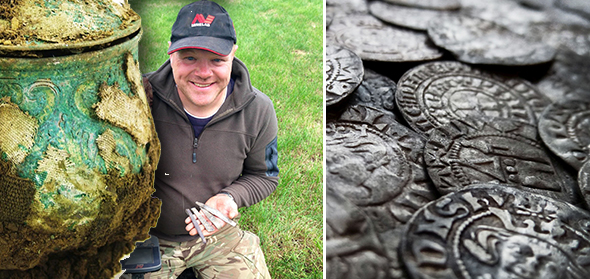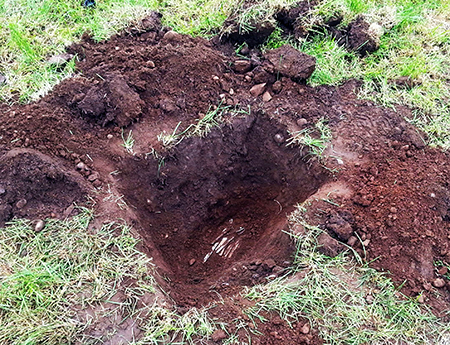
By Crystal Gomez – Gainesville Coins ……
In September 2014, a metal detector enthusiast found a spectacular stockpile of Viking legacy. According to the British Broadcasting Corporation (BBC), it is Scotland’s most significant hoard and is estimated to be worth over £1 million pounds. The cache is rumored to be the most sizable hoard found in Scotland since 1891 and consists of a myriad of medieval objects. Some of the more fantastic finds include silver ingots, solid gold jewelry, arm bands, and a silver lidded vessel with animal engravings dating back to the Holy Roman Empire.
Found in the Galloway area, of the Dumfries and Galloway region in south-west Scotland in September 2014, the assemblage is believed to be of ninth or 10th century Viking culture. The principal finds in the Viking treasure comprise of a decorative gold bird pin, a silver Carolingian pot, a solid gold ring, and a solid silver cross with gold inlay and enamel decorations, over twenty solid gold and silver ingots and dozens of solid silver arm bands decorated with saltire*-type designs.
The Norse would frequently raid and pillage the British Isles between the eighth and eleventh centuries. Because of the high traffic between the islands, some of the Scottish artifacts that were found are believed to be linked to Ireland and England. For example, the aforementioned silver cross is believed to have come from Dublin, Ireland. This research suggests that Scandinavians buried their wealth for safekeeping. They may have done this because the emigration of people from the surrounding isles increased the possibility of their belongings being stolen.
*A saltire is a diagonal cross shape that typically is associated with the Vikings.
Discovery of the Dumfries and Galloway Hoard, September 2014

Forty-seven-year-old Derek McLennan was unwilling to wake up on that fateful morning. Having been invited and given permission to go metal detecting in Dumfries that day, McLennan would normally have been enthusiastic about his plans, especially since he had already discovered two practically monumental piles of solid silver medieval coins in December 2013 & June 2014. However, he was close to not going that morning, claiming that he had been feeling ill.
Fortunately for McLennan, his two metal detecting friends didn’t let him play sick that day.
“I dragged myself out of my sickbed because … [my] two friends … wanted to detect and I’m a bit of an obsessive,” said McLennan.
Finally out on the field, McLennan began his tedious detecting. After just an hour, his apparatus detected something buried just a few feet below the ground. At first glance, he thought he had just a found a silver spoon, but after swiping his thumb across it, he saw that it was a saltire shape. He had found a solid silver Viking arm band!
The collection had been found on land belonging to the Church of Scotland and qualified for Scotland’s Treasure Trove Law. Scottish law mandates that any objects found, whose owner or owners can’t be found or known, become property of the Crown. When it comes to archaeological finds like the Dumfries hoard, the law requires that the finds be exhibited in a museum for the public’s benefit. Usually, finders qualify for a voluntary reward from the Crown to recognize them for their contributions. Even though the land was the property of the Church of Scotland, any compensation was to go to McLennan. However, it is reported that the Church and McLennan have reached an agreement on how the money will be split, although specific calculations of the proportions that each party will receive have not yet been reported. The hoard is estimated to be worth more than £1 million in market value.
Influence on Scottish History

Among the many precious metal objects found in the stockpile, there are other less common materials that were found; including glass, enamel and textiles. This combination of precious metals and auxiliary materials is typical for Viking hoards, according to experts. As mentioned earlier, it is unknown as to why the pile was buried, but Stuart Campbell of Scotland’s treasure trove unit speculates that the burials were “almost like a safety deposit box”. Only the families burying the riches would know the location and be able to extract the valuables.
Because experts believe that many of these items were once attached to specific clans or families, many of them are thought to be family heirlooms. For example, the Carolingian container was probably already 100 years old at the time it was buried, indicating that this western European pot could have been held in this family for decades. As a matter of fact, only three Carolingian vessels have ever been found and only one other with a lid. Carolingian metalwork is from the medieval Frankish ruling dynasty of Charlemagne. It’s probable that only wealthy families could afford to have objects of high value such as the vessel found in this hoard. The silver-alloy container would have been very valuable even in medieval times because of its metallic composition.
This container is one of only three pots of its kind found and it is in absolutely remarkable condition! While it is likely very delicate, the fact that it is still intact after 1,200 years is amazing, as most of these vessels are found fragmented or incomplete.
In November of this year, experts decided to have the pot’s insides scanned. After receiving permission to use Borders General Hospital’s CT scanner, the vessel was scanned. Experts found four Anglo-Saxon openworked brooches, gold ingots, silver-coated ivory beads and much more inside. They hope to extricate the items as soon as possible, without damaging the vessel.
These curious blends of materials could foster new theories of the Norse influx to Scotland. Campbell refutes the traditionally held notion that Vikings were just pillagers to a foreign land. Rather, he argues that they could have actually been active, trading members of medieval Scottish society. He speculates that these were culturally and linguistically Norse people who interacted with the Scottish population. He notes that the cultural diversity of the assemblage gives the ensemble archival importance.

There is still more to be discovered from the Galloway hoard as it has yet to receive a wide peer review by the academic archaeological community. This type of review can take years and even decades in the archaeological community and can cause difficulties in wide acceptance of new theories. Until the findings are thoroughly analyzed and reviewed, it is difficult to draw any concrete conclusions on the findings. However, whether of historical or monetary value, we can be sure that there are some hidden gems in the Galloway hoard.
* * *
We would like to thank Beyond the Beep, Ltd. for generously giving CoinWeek permission to publish the images used for this article. To learn more about their discovery, follow them at www.beyondthebeep.com





My mother’s family were all Scottish wit a bit of Viking mixed in.